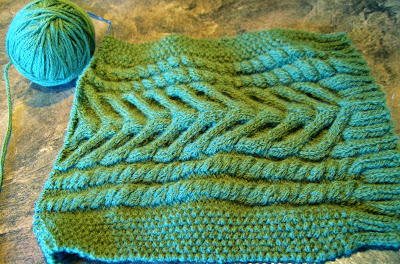Knitting patterns for sweaters almost universally start by offering directions to create the back, followed by directions for the fronts and finally the sleeves. The only exception to this order is when there are no seams at the sides; then the front and back pieces are knit together and stitches for sleeves may be picked up around the armhole. So it got me thinking:
Why are the directions to knit most sweaters started with the back?
 |
| The back of a sweater with shaping for the arms is about to happen next. |
Here's some possible reasons:
- The back is the largest piece. If it is completed first, the biggest amount of knitting is completed when the knitter has high motivation.
- Perhaps knitting patterns follow sewing patterns in order of cutting. Sewing projects generally have the biggest part cut first because smaller pieces can be worked into whatever fabric is left. In the case of a sweater the back would be the biggest piece. Perhaps the thinking is if yarn is tight, adjustments to the fronts and sleeves could be done more easily.
- The kinks of the pattern can be worked out on the back. That way once the knitter starts with the front (the showy side) the details will look better because they have already been practiced.
- The back with it's shaping for the armscye (yes, I know I'm just showing off because this is a new word to me) has already been formed. The front pieces can be aligned to it more easily.
- The back can be used to determine fit. It is the easiest piece to adjust should increases or decreases be necessary. The changes can then be applied to other parts of the sweater.
- It is just tradition. Patterns have been written this way from the beginning and so they continue to be created in the same order.
But just because patterns are written in a certain order, to my knowledge, there's no reason they have to be knit in that order. I am unaware of any knitting police. If they do exist, I should have been arrested several times over for all sorts of knitting offenses. It seems to me one can start with a sleeve or a front piece without any serious consequences. For example, I'm not so sure the back serves any better to check fit than a front piece, nor does it make any sense that doing the back first will help motivate the knitter to finish the entire sweater. Having the back done means there's a bigger knitting investment in the project, that's all. Does that motivate? I'm afraid the answer depends on the knitter.
 |
| My Fisherman Pullover back section. |
There are certain unflappable rules regarding knitting including reading an entire pattern through so there's a clear understand of what needs to be done and knitting a swatch to check on gauge. One only needs to avoid doing either of these once and it is never forgotten again. (Frogging is no fun.)
Perhaps I'm just a rebel with a pair of knitting needles, but it seems to me just because a pattern is written in a prescribed order doesn't mean it has to be knit it in that order, especially if the only reason for that particular order is tradition. There aren't laws about knitting so if I feel like knitting a sleeve first I do. Many a baby sweater has been knit not following the order and they've all worked out for me. Having said this for myself, there is no need to necessarily follow my example either. Feel free to read the pattern through and decide where you'd like to start. Then just knit.


Comments
Post a Comment